Low high MERCEDES-BENZ G500 2002 W463 Owner's Guide
[x] Cancel search | Manufacturer: MERCEDES-BENZ, Model Year: 2002, Model line: G500, Model: MERCEDES-BENZ G500 2002 W463Pages: 385, PDF Size: 30.37 MB
Page 286 of 385
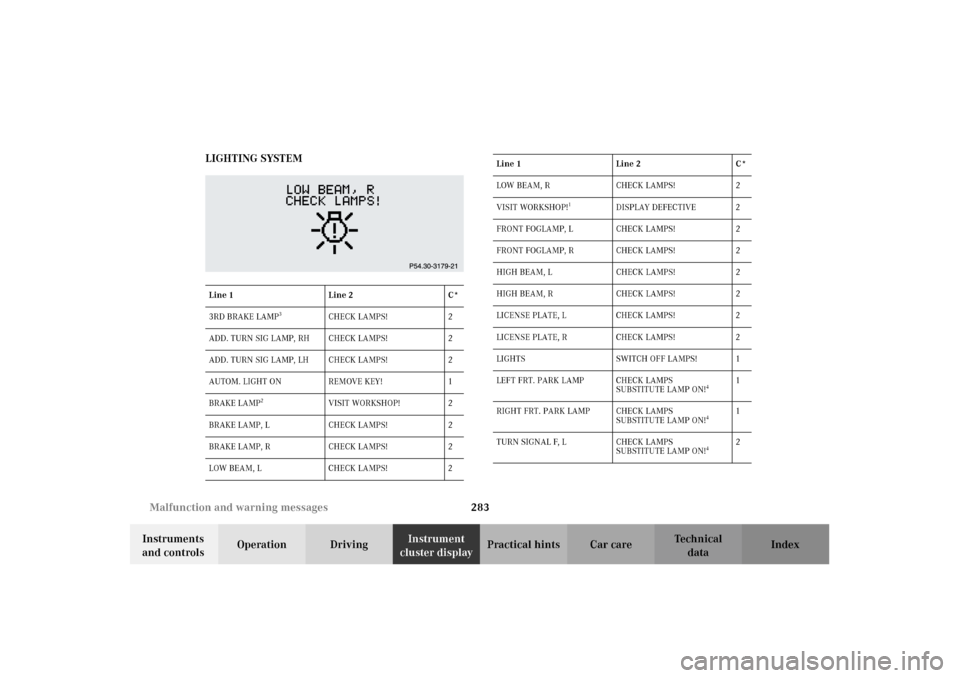
283 Malfunction and warning messages
Te ch n i c a l
data Instruments
and controlsOperation DrivingInstrument
cluster displayPractical hints Car care Index LIGHTING SYSTEM
Line 1 Line 2 C*
3RD BRAKE LAMP
3
CHECK LAMPS! 2
ADD. TURN SIG LAMP, RH CHECK LAMPS! 2
ADD. TURN SIG LAMP, LH CHECK LAMPS! 2
AUTOM. LIGHT ON REMOVE KEY! 1
BRAKE LAMP
2
VISIT WORKSHOP! 2
BRAKE LAMP, L CHECK LAMPS! 2
BRAKE LAMP, R CHECK LAMPS! 2
LOW BEAM, L CHECK LAMPS! 2
LOW BEAM, R CHECK LAMPS! 2
VISIT WORKSHOP!
1
DISPLAY DEFECTIVE 2
FRONT FOGLAMP, L CHECK LAMPS! 2
FRONT FOGLAMP, R CHECK LAMPS! 2
HIGH BEAM, L CHECK LAMPS! 2
HIGH BEAM, R CHECK LAMPS! 2
LICENSE PLATE, L CHECK LAMPS! 2
LICENSE PLATE, R CHECK LAMPS! 2
LIGHTS SWITCH OFF LAMPS! 1
LEFT FRT. PARK LAMP CHECK LAMPS
SUBSTITUTE LAMP ON!
4
1
RIGHT FRT. PARK LAMP CHECK LAMPS
SUBSTITUTE LAMP ON!
4
1
TURN SIGNAL F, L CHECK LAMPS
SUBSTITUTE LAMP ON!
4
2 Line 1 Line 2 C*
J_G463.book Seite 283 Mittwoch, 19. September 2001 8:06 08
Page 296 of 385
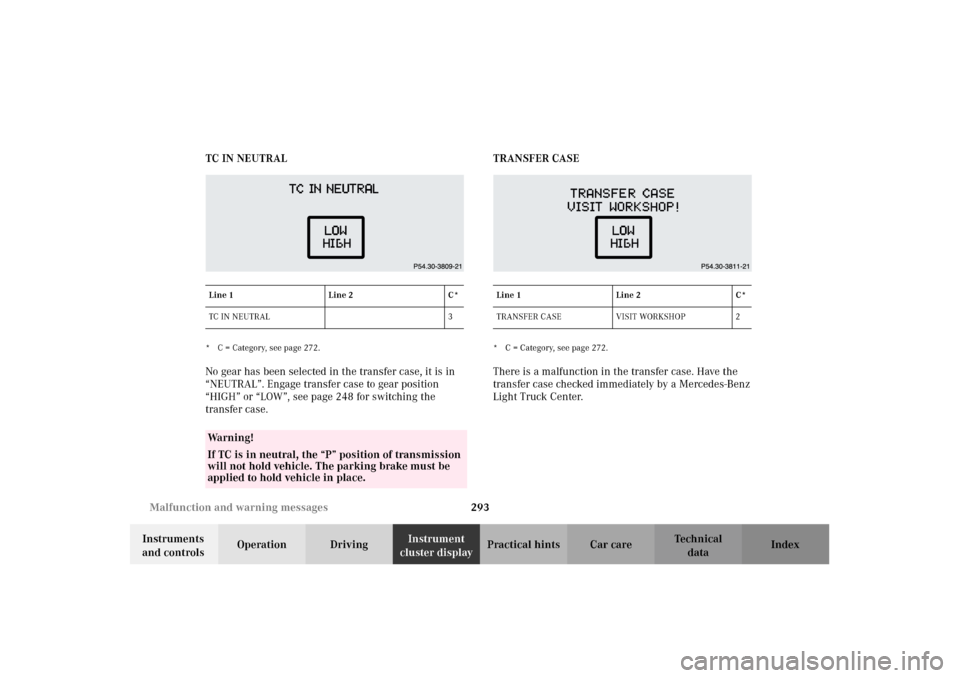
293 Malfunction and warning messages
Te ch n i c a l
data Instruments
and controlsOperation DrivingInstrument
cluster displayPractical hints Car care Index TC IN NEUTRAL
* C = Category, see page 272.No gear has been selected in the transfer case, it is in
“NEUTRAL”. Engage transfer case to gear position
“HIGH” or “LOW”, see page 248 for switching the
transfer case.TRANSFER CASE
* C = Category, see page 272.There is a malfunction in the transfer case. Have the
transfer case checked immediately by a Mercedes-Benz
Light Truck Center.
Line 1 Line 2 C*
TC IN NEUTRAL 3Wa r n i n g !
If TC is in neutral, the “P” position of transmission
will not hold vehicle. The parking brake must be
applied to hold vehicle in place.
Line 1 Line 2 C*
TRANSFER CASE VISIT WORKSHOP 2
J_G463.book Seite 293 Mittwoch, 19. September 2001 8:06 08
Page 310 of 385
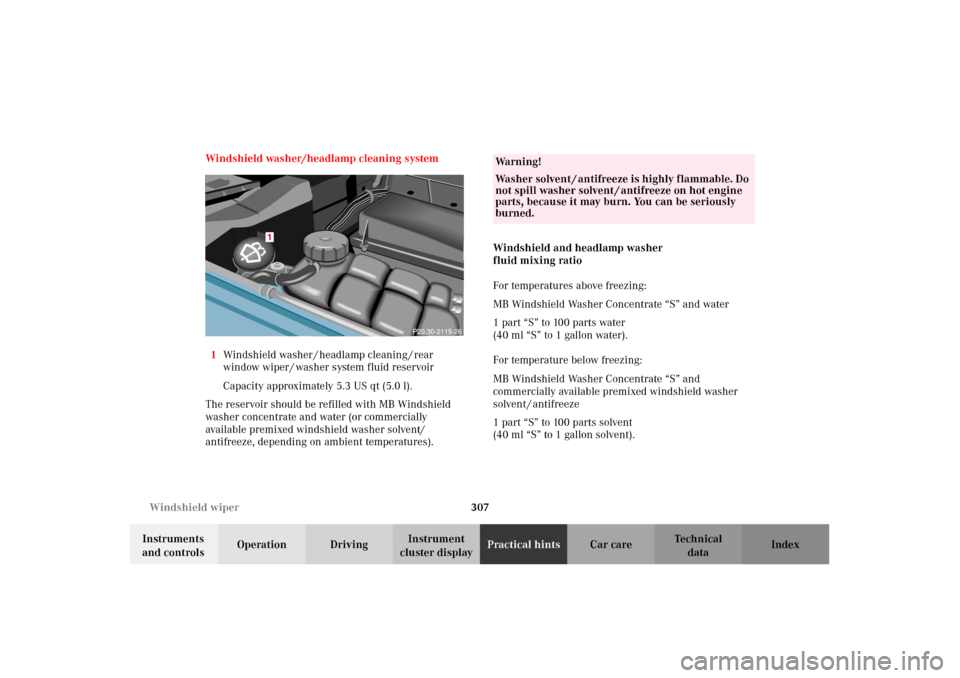
307 Windshield wiper
Te ch n i c a l
data Instruments
and controlsOperation DrivingInstrument
cluster displayPractical hintsCar care Index Windshield washer/headlamp cleaning system
1Windshield washer / headlamp cleaning / rear
window wiper / washer system fluid reservoir
Capacity approximately 5.3 US qt (5.0 l).
The reservoir should be refilled with MB Windshield
washer concentrate and water (or commercially
available premixed windshield washer solvent/
antifreeze, depending on ambient temperatures).Windshield and headlamp washer
fluid mixing ratio
For temperatures above freezing:
MB Windshield Washer Concentrate “S” and water
1 part “S” to 100 parts water
(40 ml “S” to 1 gallon water).
For temperature below freezing:
MB Windshield Washer Concentrate “S” and
commercially available premixed windshield washer
solvent / antifreeze
1 part “S” to 100 parts solvent
(40 ml “S” to 1 gallon solvent).
1
Wa r n i n g !
Washer solvent / antifreeze is highly flammable. Do
not spill washer solvent / antifreeze on hot engine
parts, because it may burn. You can be seriously
burned.
J_G463.book Seite 307 Mittwoch, 19. September 2001 8:06 08
Page 321 of 385
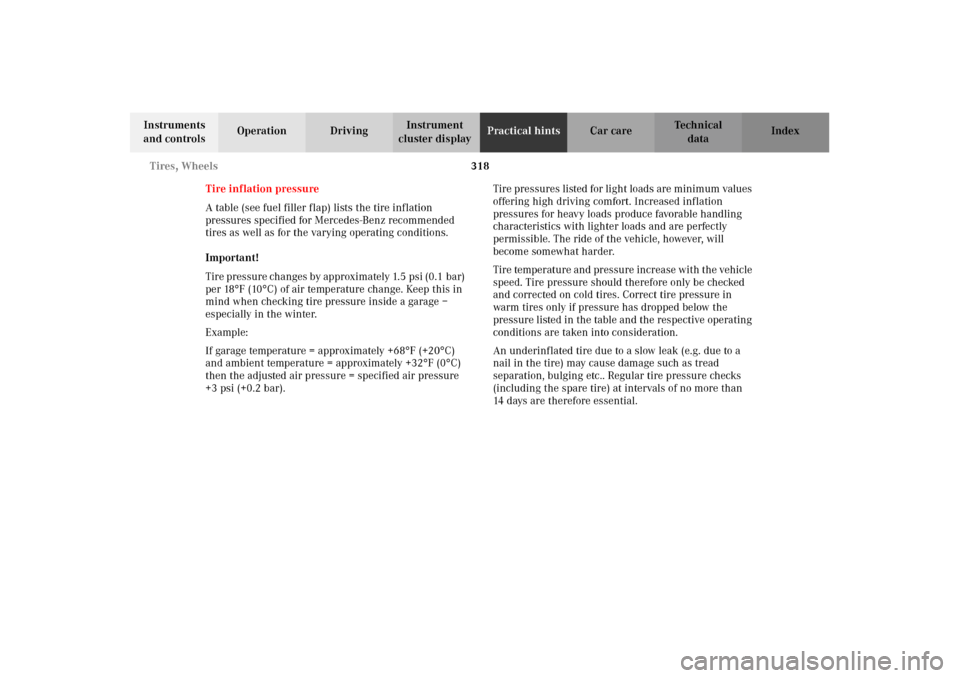
318 Tires, Wheels
Te ch n i c a l
data Instruments
and controlsOperation DrivingInstrument
cluster displayPractical hintsCar care Index
Tire inflation pressure
A table (see fuel filler flap) lists the tire inflation
pressures specified for Mercedes-Benz recommended
tires as well as for the varying operating conditions.
Important!
Tire pressure changes by approximately 1.5 psi (0.1 bar)
per 18
°F (10
°C) of air temperature change. Keep this in
mind when checking tire pressure inside a garage –
especially in the winter.
Example:
If garage temperature = approximately +68
°F (+20
°C)
and ambient temperature = approximately +32
°F (0
°C)
then the adjusted air pressure = specified air pressure
+3 psi (+0.2 bar).Tire pressures listed for light loads are minimum values
offering high driving comfort. Increased inflation
pressures for heavy loads produce favorable handling
characteristics with lighter loads and are perfectly
permissible. The ride of the vehicle, however, will
become somewhat harder.
Tire temperature and pressure increase with the vehicle
speed. Tire pressure should therefore only be checked
and corrected on cold tires. Correct tire pressure in
warm tires only if pressure has dropped below the
pressure listed in the table and the respective operating
conditions are taken into consideration.
An underinflated tire due to a slow leak (e.g. due to a
nail in the tire) may cause damage such as tread
separation, bulging etc.. Regular tire pressure checks
(including the spare tire) at intervals of no more than
14 days are therefore essential.
J_G463.book Seite 318 Mittwoch, 19. September 2001 8:06 08
Page 326 of 385
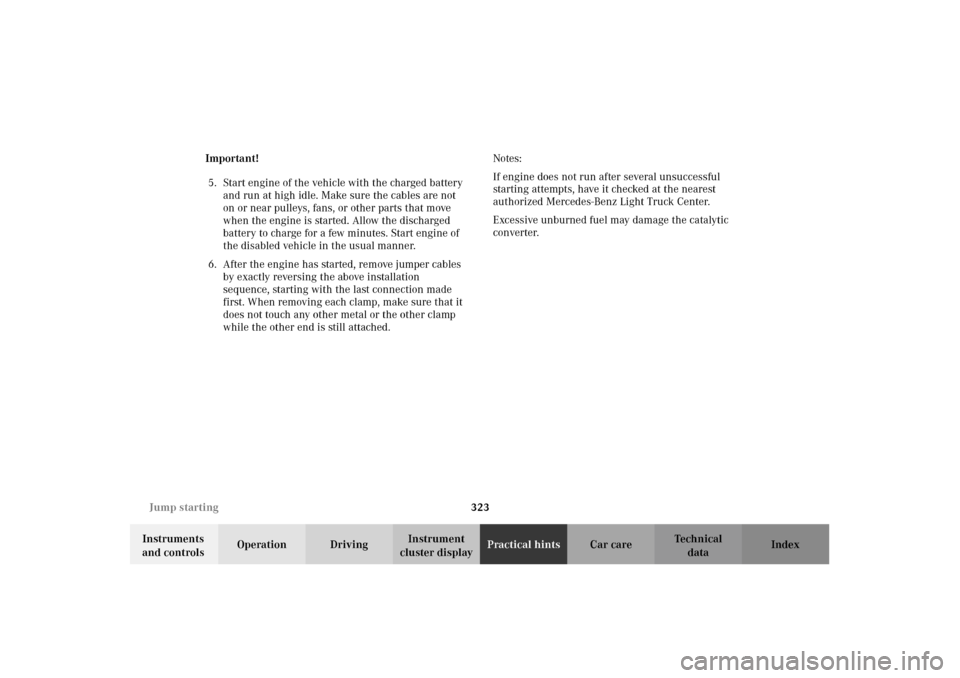
323 Jump starting
Te ch n i c a l
data Instruments
and controlsOperation DrivingInstrument
cluster displayPractical hintsCar care Index Important!
5. Start engine of the vehicle with the charged battery
and run at high idle. Make sure the cables are not
on or near pulleys, fans, or other parts that move
when the engine is started. Allow the discharged
battery to charge for a few minutes. Start engine of
the disabled vehicle in the usual manner.
6. After the engine has started, remove jumper cables
by exactly reversing the above installation
sequence, starting with the last connection made
first. When removing each clamp, make sure that it
does not touch any other metal or the other clamp
while the other end is still attached.Notes:
If engine does not run after several unsuccessful
starting attempts, have it checked at the nearest
authorized Mercedes-Benz Light Truck Center.
Excessive unburned fuel may damage the catalytic
converter.
J_G463.book Seite 323 Mittwoch, 19. September 2001 8:06 08
Page 327 of 385
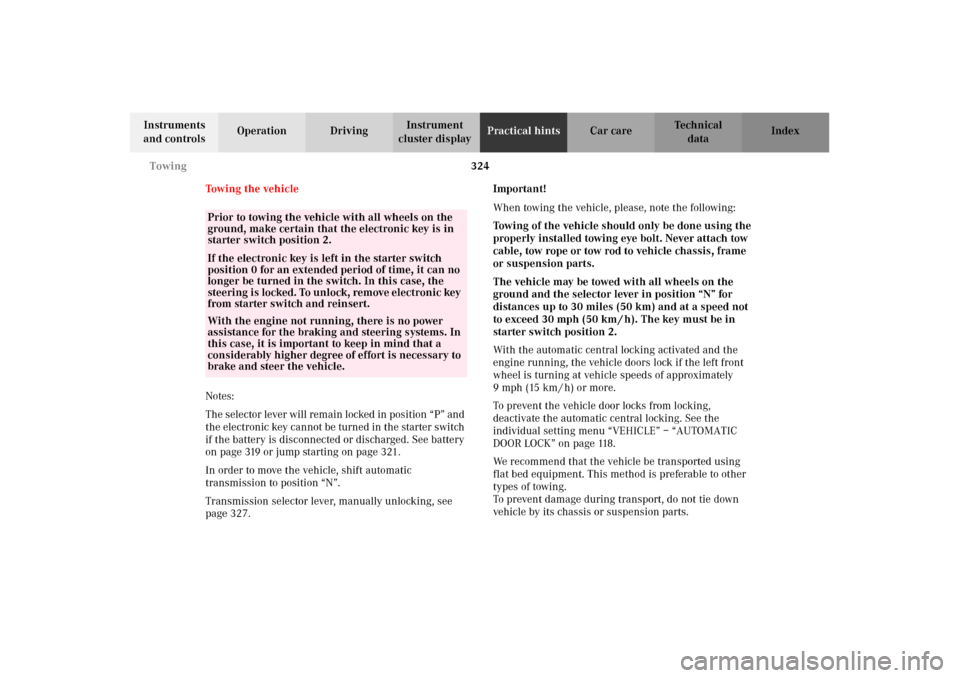
324 Towing
Te ch n i c a l
data Instruments
and controlsOperation DrivingInstrument
cluster displayPractical hintsCar care Index
Towing the vehicle
Notes:
The selector lever will remain locked in position “P” and
the electronic key cannot be turned in the starter switch
if the battery is disconnected or discharged. See battery
on page 319 or jump starting on page 321.
In order to move the vehicle, shift automatic
transmission to position “N”.
Transmission selector lever, manually unlocking, see
page 327.Important!
When towing the vehicle, please, note the following:
Towing of the vehicle should only be done using the
properly installed towing eye bolt. Never attach tow
cable, tow rope or tow rod to vehicle chassis, frame
or suspension parts.
The vehicle may be towed with all wheels on the
ground and the selector lever in position “N” for
distances up to 30 miles (50 km) and at a speed not
to exceed 30 mph (50 km / h). The key must be in
starter switch position 2.
With the automatic central locking activated and the
engine running, the vehicle doors lock if the left front
wheel is turning at vehicle speeds of approximately
9 mph (15 km / h) or more.
To prevent the vehicle door locks from locking,
deactivate the automatic central locking. See the
individual setting menu “VEHICLE” – “AUTOMATIC
DOOR LOCK” on page 118.
We recommend that the vehicle be transported using
flat bed equipment. This method is preferable to other
types of towing.
To prevent damage during transport, do not tie down
vehicle by its chassis or suspension parts.
Prior to towing the vehicle with all wheels on the
ground, make certain that the electronic key is in
starter switch position 2.If the electronic key is left in the starter switch
position 0 for an extended period of time, it can no
longer be turned in the switch. In this case, the
steering is locked. To unlock, remove electronic key
from starter switch and reinsert.
With the engine not running, there is no power
assistance for the braking and steering systems. In
this case, it is important to keep in mind that a
considerably higher degree of effort is necessary to
brake and steer the vehicle.
J_G463.book Seite 324 Mittwoch, 19. September 2001 8:06 08
Page 333 of 385
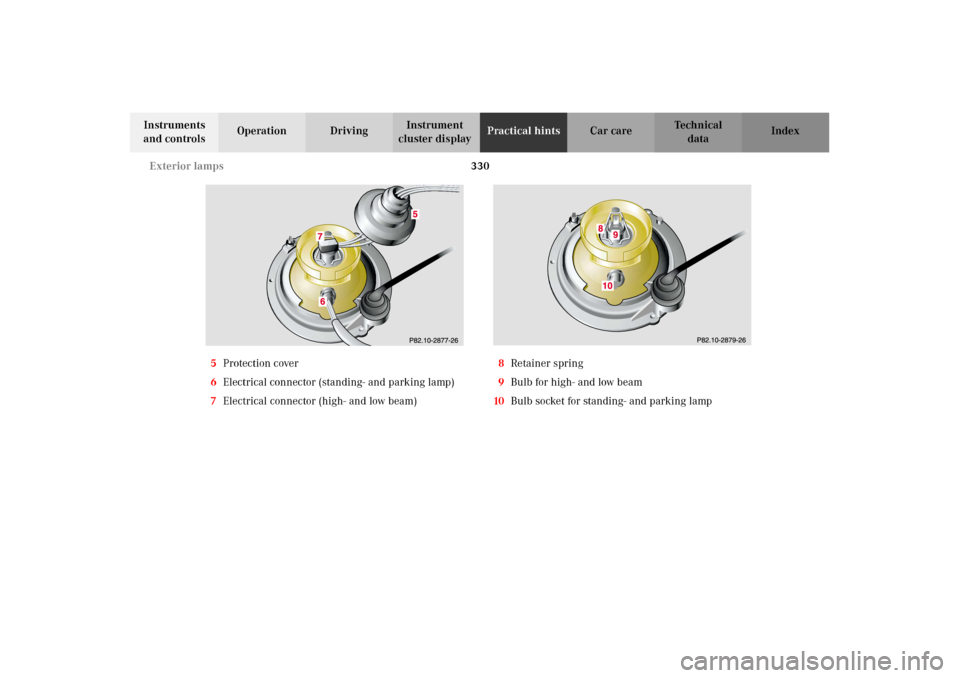
330 Exterior lamps
Te ch n i c a l
data Instruments
and controlsOperation DrivingInstrument
cluster displayPractical hintsCar care Index
5Protection cover
6Electrical connector (standing- and parking lamp)
7Electrical connector (high- and low beam)8Retainer spring
9Bulb for high- and low beam
10Bulb socket for standing- and parking lamp
J_G463.book Seite 330 Mittwoch, 19. September 2001 8:06 08
Page 334 of 385

331 Exterior lamps
Te ch n i c a l
data Instruments
and controlsOperation DrivingInstrument
cluster displayPractical hintsCar care Index Bulbs for low and high beam
H4 60 / 55W 12V
Remove protection cover (5) and pull off electrical
connector (6).
Unclip retainer spring (8) and take out bulb (9).
Insert new bulb so that the base locates in the recess on
the holder.
Clip in retainer spring (8), plug the electrical
connector (6) onto the bulb (9) and press on protection
cover (5).
Bulbs for parking and standing lamp
T 4W 12V
Pull off electrical connector (6) from the bulb (10).
Push bulb (10) into socket, turn counterclockwise and
remove.
Insert new bulb (10) in socket, push in and turn
clockwise until it clicks in.
Plug electrical connector (6) onto the bulb (10).To reinstall headlamp:
Insert headlamp (3) and screw in headlamp-securing
screws (4).
Install head lamp trim panel (2) and seal and screw in
securing screws (1).
J_G463.book Seite 331 Mittwoch, 19. September 2001 8:06 08
Page 365 of 385
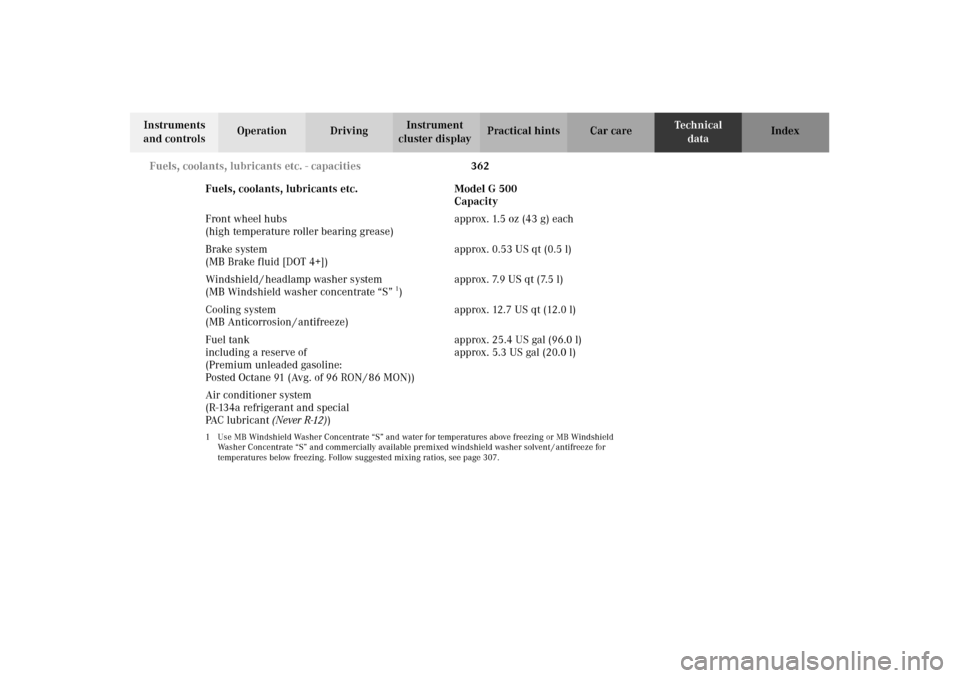
362 Fuels, coolants, lubricants etc. - capacities
Te ch n i c a l
data Instruments
and controlsOperation DrivingInstrument
cluster displayPractical hints Car care Index
Front wheel hubs
(high temperature roller bearing grease)approx. 1.5 oz (43 g) each
Brake system
(MB Brake fluid [DOT 4+])approx. 0.53 US qt (0.5 l)
Windshield / headlamp washer system
(MB Windshield washer concentrate “S”
1)approx. 7.9 US qt (7.5 l)
Cooling system
(MB Anticorrosion / antifreeze)approx. 12.7 US qt (12.0 l)
Fuel tank
including a reserve of
(Premium unleaded gasoline:
Posted Octane 91 (Avg. of 96 RON / 86 MON))approx. 25.4 US gal (96.0 l)
approx. 5.3 US gal (20.0 l)
Air conditioner system
(R-134a refrigerant and special
PA C l u b r ic a n t (Never R-12))
1 Use MB Windshield Washer Concentrate “S” and water for temperatures above freezing or MB Windshield
Washer Concentrate “S” and commercially available premixed windshield washer solvent / antifreeze for
temperatures below freezing. Follow suggested mixing ratios, see page 307.Fuels, coolants, lubricants etc. Model G 500
Capacity
J_G463.book Seite 362 Mittwoch, 19. September 2001 8:06 08
Page 370 of 385

367 Consumer information
Te ch n i c a l
data Instruments
and controlsOperation DrivingInstrument
cluster displayPractical hints Car care Index Consumer information
This has been prepared as required of all manufactures
of passenger cars under Title 49, Code of U.S. Federal
Regulations, Part 575 pursuant to the “National Traffic
and Motor Vehicle Safety Act of 1966”.
Uniform tire quality grading
Quality grades can be found where applicable on the
tire sidewall between tread shoulder and maximum
section width. For example:
All passenger vehicle tires must conform to federal
safety requirements in addition to these grades.Treadwear
The treadwear grade is a comparative rating based on
the wear rate of the tire when tested under controlled
conditions on a specified government test course. For
example, a tire graded 150 would wear one and one-half
(1
1/2) times as well on the government course as a tire
graded 100. The relative performance of tires depends
upon the actual conditions of their use, however, and
may depart significantly from the norm due to
variations in driving habits, service practices and
differences in road characteristics and climate.
Traction
The traction grades, from highest to lowest are AA, A, B,
and C. Those grades represent the tire’s ability to stop
on wet pavement as measured under controlled
conditions on specified government test surfaces of
asphalt and concrete. A tire marked C may have poor
traction performance. Tread wear 200 Traction AA Temperature A
Wa r n i n g !
The traction grade assigned to this tire is based on
straight ahead braking traction tests, and does not
include acceleration, cornering, hydroplaning, or
peak traction characteristics.
J_G463.book Seite 367 Mittwoch, 19. September 2001 8:06 08